Aquascapinig became a very popular hobby thanks to Takashi Amano- a Japan Photographer who developed and was a great master in underwater plant art. Art? Yes. This is art! Do you think that this is not for you because you were bad in drawing in kindergarten? You can’t be more worse. The art reflected in the planted tank is not limited to the arrangement but includes also many scientific aspects of the hobby which are also interesting and challenging. Therefore anybody who likes nature and water should try this hobby and experience the fun of having your own treasure called the nature planted aquarium!
Today let’s talk about how to aquascape from the beginning in terms of arrangement and selecting aquarium plants.
Japanese conceptions of the nature aquarium arrangements
Aquascaping is the art developed mainly in Japan as the art of underwater gardening. There are 3 types of the nature aquarium types defined by the Japanese masters of aquascaping:
Ryuboku
This style allows to use both wood and stones and variety of aquatic plants- from the tall ones to low carpet plants. This style is often use to reflect the forest-like landscape. Thanks to flexible assumptions of Ryuboku, this is the most popular style.
Iwagumi
The oldest conception of the nature aquarium allowing to use only rocks. Iwagumi aquascape is usually composed with low carpeting plants. Based on asymmetric composition of rocks, resembling the natural rock formation.
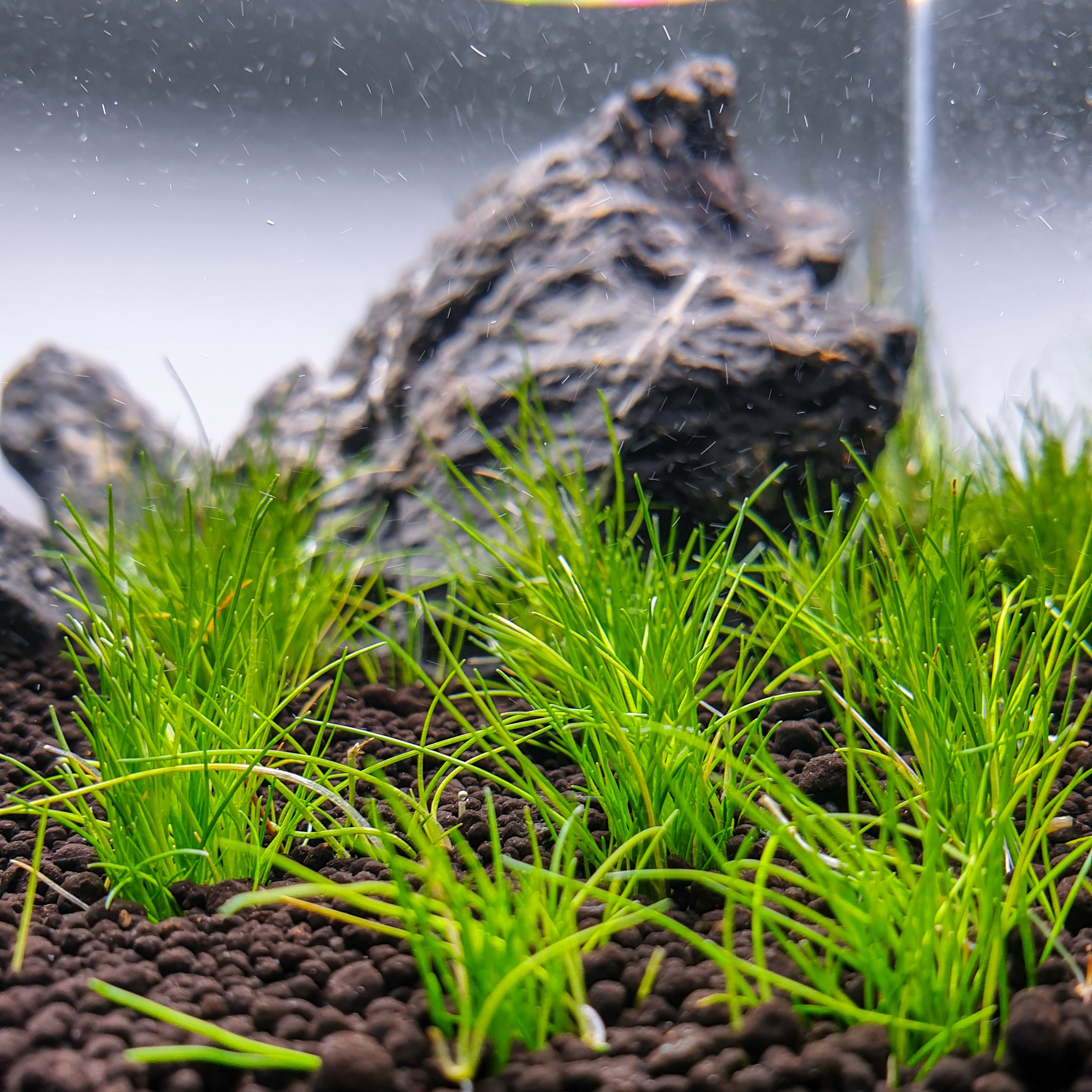
Mizube
The continuation of the Ryuboku style but with plants growing about the water surface. This means that doing this style eliminates the possibility of having jumping fish. For open-tank fans this conception is surely attractive while allows to grow more kind of plant species.
Ragwork
This is the youngest style and has not many rules to follow. The base is the mountain-looking rock formation reflecting the natural hills and mountain slopes. Usually combined by low greenery, including moss and aquatic grass.
Although there is the literature behind the nature aquariums, aquascaping in practice verified them itself and added a few configurations of the hardscape which are the base of the final look of the aquascape. Unfortunately, the concept is not everything in this hobby. See the basic rules and things that should be taken into the account before planning your first aquascape!
The good-looking arrangement doesn’t mean the successful planted tank
Let’s start from the basic rules of planning the arrangement! Firstly, be aware that the final look of your planted tank will be completely different than in the beginning. Everything depends on the amount of plants being planted, the hardscape configuration and maintenance in general (trimming, proper fertilizing, light intensity, CO2 dosing, water changes etc.). Everything what happens in the ecosystem needs to be under control of the owner, otherwise the tank will look messy, unhealthy and instead of the interior decoration you will have a neglected scary tank. So keeping balanced water parameters, doing frequent water changes and regular trimming are essential for any planted tank to thrive.
So here is the rule number one: Even the best arrangement unless maintained regularly may become a disaster.
Convex, concave, triangular setup?
The main aquascaping styles are based on the hardscape configuration. Depending on the layout, we can select the placement of the chosen plant species and partially predict the growth. In the art of the nature aquariums we can divide the layout into three configurations:
Convex arrangement
The tallest plants grow in the central part of the tank, and the lowest on the sides. This type of arrangement is used for creating an island and allows to easily reach the inner site of the aquarium glass and clean it accurately.
Concave arrangement
This one is opposite to convex- tall plants grow on the sides of the tank while the lowest plants species are planted in the focal point. Works perfectly in forest-like and valley-like setups.
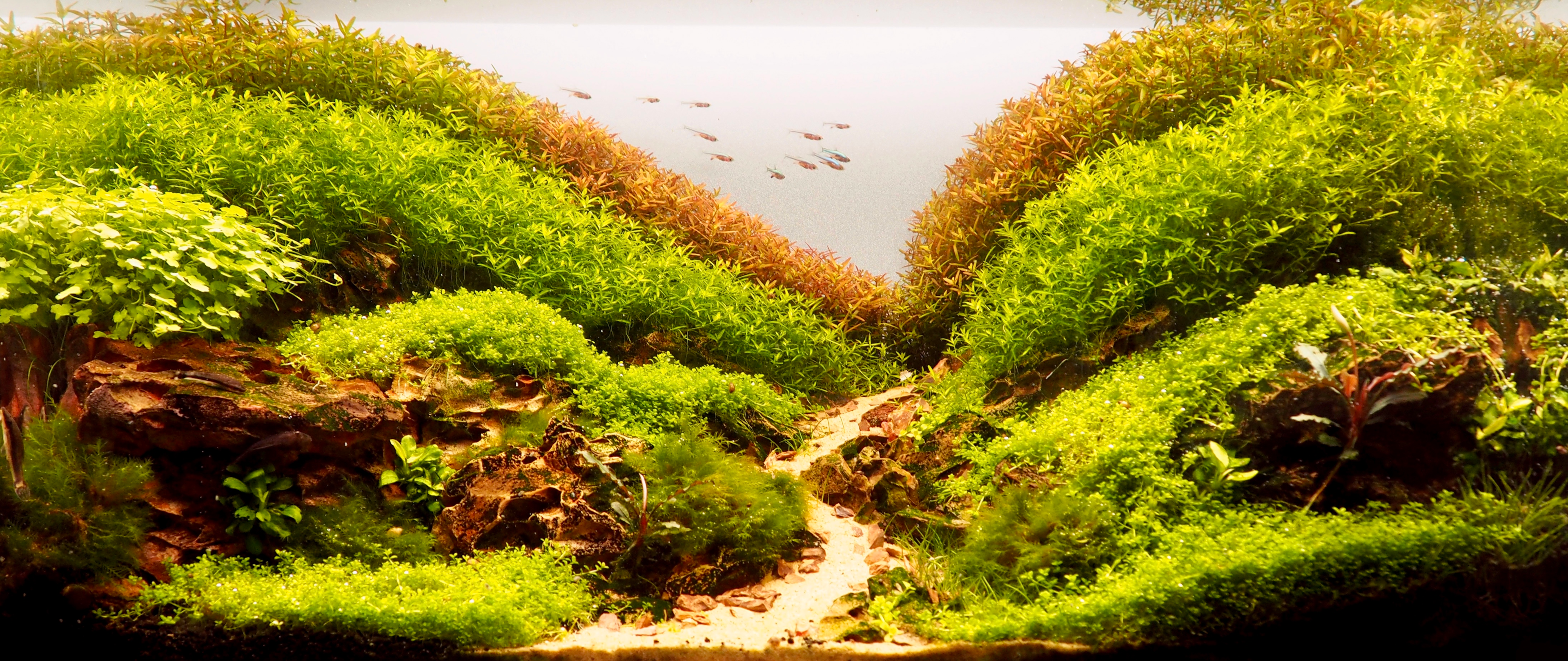
Triangle scape
An interesting type of arrangement. It works very well if we properly integrate it into our apartment. For example, an aquarium in the corner of the room. The tallest plants are planted on the left or right side wall. On the opposite side, the plants are the lowest (lawn). Makes the space compact and consistent.
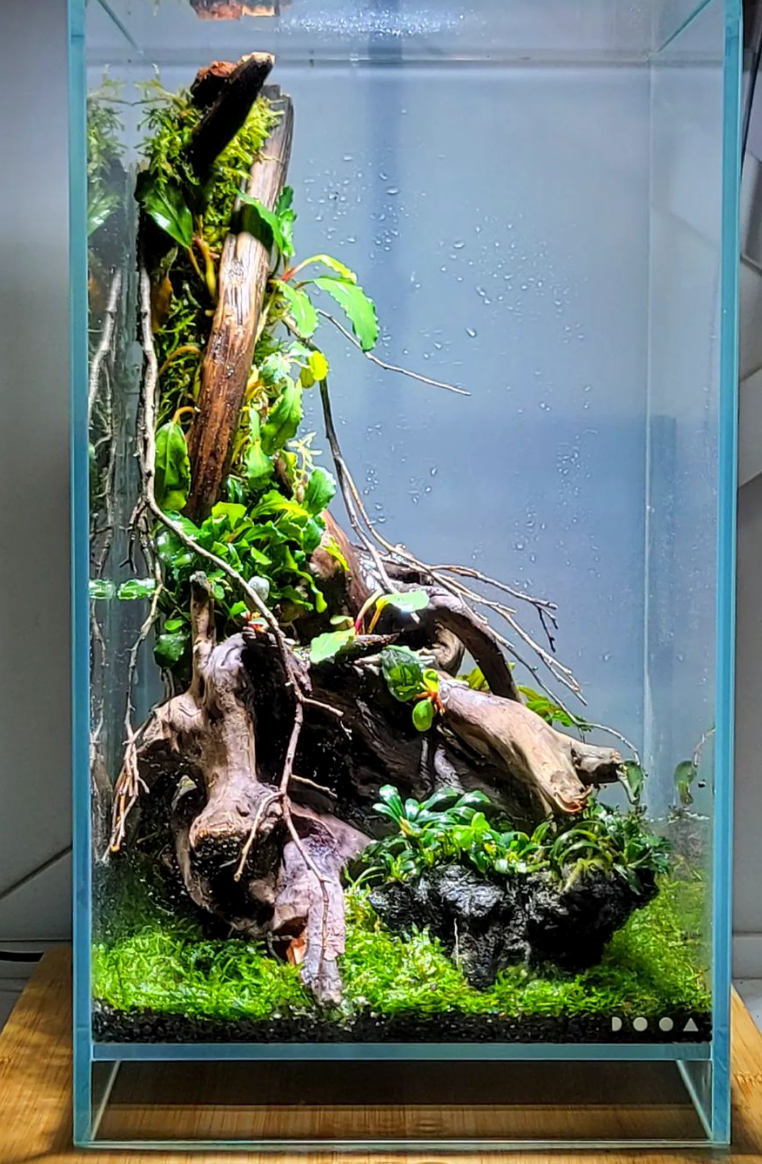
Positioning the hardscape according to your vision is super important here. Then you can play with the wood and stones with creativity and imagine how it would look like covered with plants? Your instinct will tell you 🙂
What is the hardscape?
Hardscape materials are roots, wood, rocks or stones. They are the base of the arrangement so it’s worth considering different configurations. When choosing random stones and wood from the neighborhood be aware that they need special preparation before introducing them to the aquarium. This is because they release organic compounds due to the change of environment, putrefactive processes begin and you may experience serious problems with the water parameters. Water may become cloudy and the overall appearance of the tank would’t rather look desirable.
Therefore it’s worth buying the hardscape materials from reliable sources where you can be sure that they are dedicated for aquarium use. Remember that there are hardscape materials affecting water parameters on purpose.
For example, limestone that is used in Malawi and Tanganika biotopes. Fish living in these lakes are used to the increased acidity levels and do well in higher pH. Limestone helps harden the water and increases the pH level of water. Most of freshwater fish prefer softer water. Therefore limestone should be used only in aquariums with high acidity levels where soft water is harmful for fish (e.g. African cichlids).
Limestone is not the only material affecting the water column therefore it’s best to do a wide research before making the final decision.
Substrate
Another element of the aquarium arrangement is the substrate you want to use. Will it be a gravel or fine sand? Soil substrate or dirt? Again, imagination and creativity must be turned on! And a bit of knowledge too 😉
Generally, the substrate with a grain size of 1 to 3 mm works best. Of course, there is no answer to the question: what granulation will be the best for each aquarium – it all depends on what you want to grow in it, however, for safe granulation for all bottom dwelling fish, oscillations in the range of 3 to 10 mm. Remember that the 3 – 10 mm grain size litter will have smooth edges, so it will be suitable for all your fish.
Correctly selected gravel or sand is a great foundation for live plants that will support their proper development and prevent the growth of harmful bacteria and microorganisms in the planted tank. The choice of a substrate for a general aquarium is extremely important, because it mainly determines the optimal development of every living organism.
Active substrate- not for every setup
In aquarium trade you may find a various range of activated substrates. They have a few functions such as filtration abilities, affect on pH, GH, KH stable levels. They are created for the most lush plant growth so except of the perfect granulation, they often are enriched with fertilizers helping your aquatic plants to root strongly and grow healthy.
However, the active substrate is not a good biotope for some biotope aquariums. The active substrate often absorbs e.g. the humic compounds conditioning the black water environment so in such examples using this product is useless.
Choose natural colors
Avoid unnatural colors of the substrate and other equipment. The nature style is characterized by super natural look so avoid artificial decorations or substrate. Instead you may add some colorful community fish thriving in front of the natural background.
Lighting
Aquarium lighting is not only the part of mandatory equipment but also the light position is responsible for the overall look of the tank. It’s good to invest in high quality lighting although the strongest doesn’t mean the best.
The balanced light absorption by plants depends on the light quality and its’s ability to reach the plants growing under water surface. We recommend LED lights which are quite reliable. Find the science of lighting in the planted aquarium and how to count the light parameters for your aquarium in our article!
In terms of aquascaping, apart from the light parameters that are suitable for plants and fish*, lighting is a great option to play with the background. Additional lamp behind the background can be arranged for the sunset or beautiful-weather mood when combined with a bluish background.
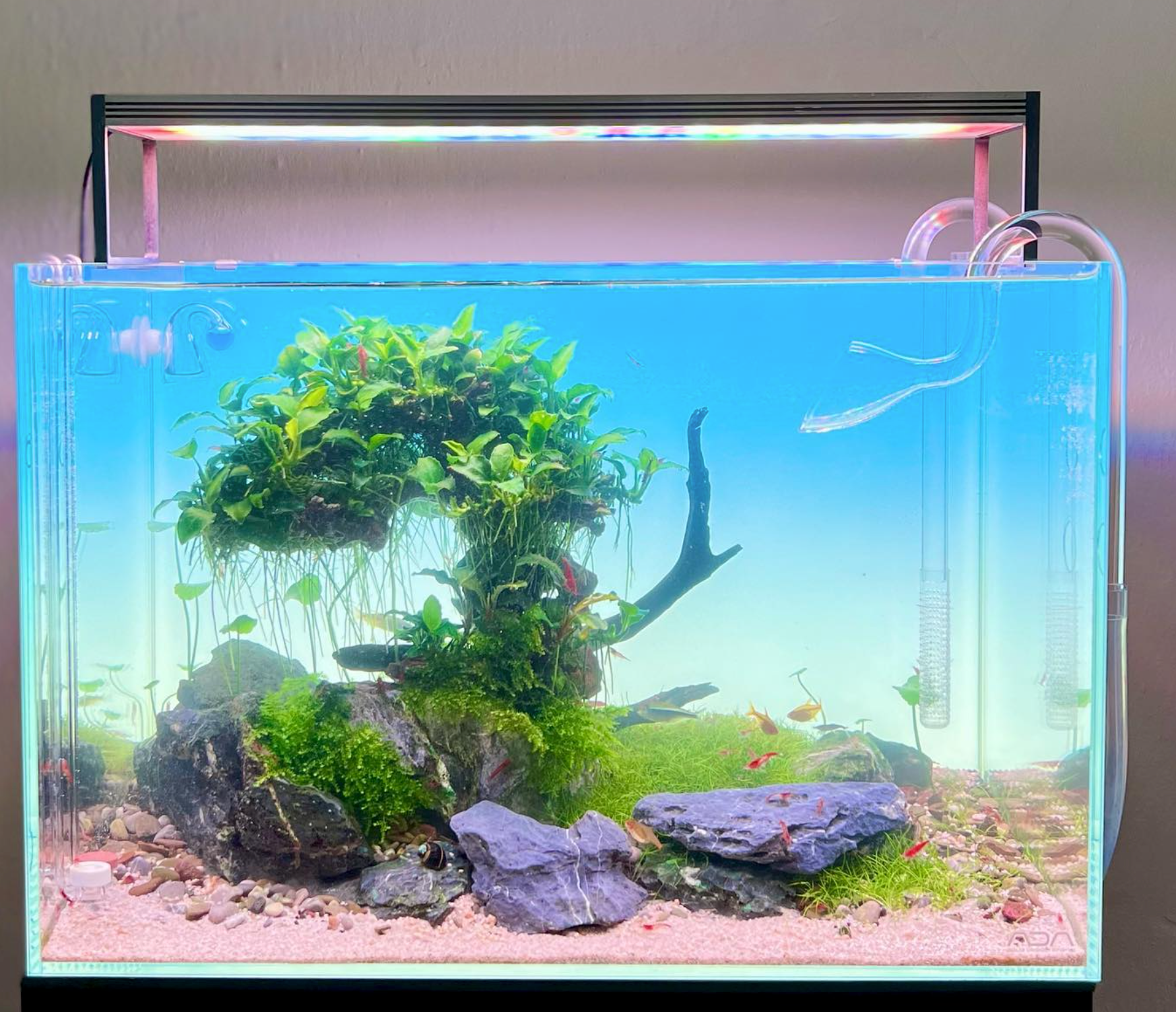
*yes fish! some fish feel shy in bright lighting because in nature they occur in cloudy or even moldy waters. In this case, adding some floating plants can be a super solution as they dim the lighting and become a natural barrier between the fish and lights.
Avoid straight lines!
This is probably the most important rule here. Straight lines between substrate layers or narrow and straight gravel paths definitely spoil the natural feeling. Also the hardscape combination should be somehow asymmetric. Just imagine natural landscapes and their creativity of Mother Nature. And try to reflect it in your tank- of course with the visualisation of the desired effect!
Aquarium size is super important
Remember that the surface and height of your tank are the key for plant selection. For smaller aquariums big-leaved species are not recommended, as well as plants that grow tall. The less space in the tank, the less space plants have to grow. For small tanks or nano tanks choose low growing plants e.g. carpeting plants or ferns. Rosette, dense growing plants are recommended for larger aquariums where they can show their best.
Plant selection
Depending on the arrangement type you decide on (convex, concave, triangular), you should plant the greenery according to the rule. Of course, you imagination is your only limitation, although if it’s the beginning of your story, it’s recommended to follow these arrangement rules to understand this art.
In this part present a short list of aquarium plants that are compatible to each other and can be grown in the same aquarium as they have similar requirements (they will be mentioned in the end of the below list). This list contains easy to grow aquarium plants so any beginner can catch this list and start the journey with the nature-inspired aquarium!
Let’s divide them into tall, medium, low and floating. This will help you to plan the arrangement according the aquascaping styles we mentioned above.
Tall plants
Tall plants are usually the background plants in planted aquariums however in case of convex configuration, they are used in the middle ground as the center of the island.
Anubias
This plant has so many varieties that everyone will find the species for himself that will impress with the leave shape or colour. For beginners, Anubias nana is a great choice. Depending on the light intensity you may expect different results in plant growth. When kept under low lighting, its colouration is darker. You may receive brighter leaves with intensified lighting although this should be correlated with CO2 injection. Otherwise you may expect algae on the leaves. Quite wide leaves of this variety can easily fill the space in the background or become the heart of the island.
Rotala
Rotala also occurs in wide shapes and colors. Red, orange, greenish- you will surely find your favourite variety. It’s definitely a plant that prefers medium-lighting. Balanced photosynthesis with CO2 will surely help to grow a compact formation being a contrast to the green vegetation. You can plant it over and over by placing the cuttings in the substrate and support the growth with the root tabs.
Medium-tall plants
These plants should be placed in the middle part of the tank. They can contrast with the background making more spacious feeling. The plants of the middle height should be the background for smaller plants like carpet plants or low ferns.
Bacopa
Again- a wide range of this species is available in aquarium trade. This aquarium plants is worth planting in front of the taller plant as it releases beautiful tiny flowers of different colour depending on the species. It’s recommended to plant a few settlings as the compact formation looks more aesthetically than single stems.
Alternanthera reineckii
This stunning red plant is one of a few red plants used in the aquarium for mid ground purpose. It likes mid-lighting with CO2 fertilizing, which fastens its rather slow growth. If the leaves on the bottom become brownish, the light should be intensified. While planting it’s good to make larger spaces between each cutting as this plant grows widely. Old leaves should be removed on a regular basis as this makes space for the new shoots to grow.
Cryptocoryne
This plants consists of many different varieties and species, differing in leave shape, height and colouration. This plant is recommended for mid ground our background of the tank. It’s rather a slow grower but with proper CO2 injection and medium lighting it will take over the tank rapidly. Therefore regular trimming is recommended which will also encourage new shoots growth.
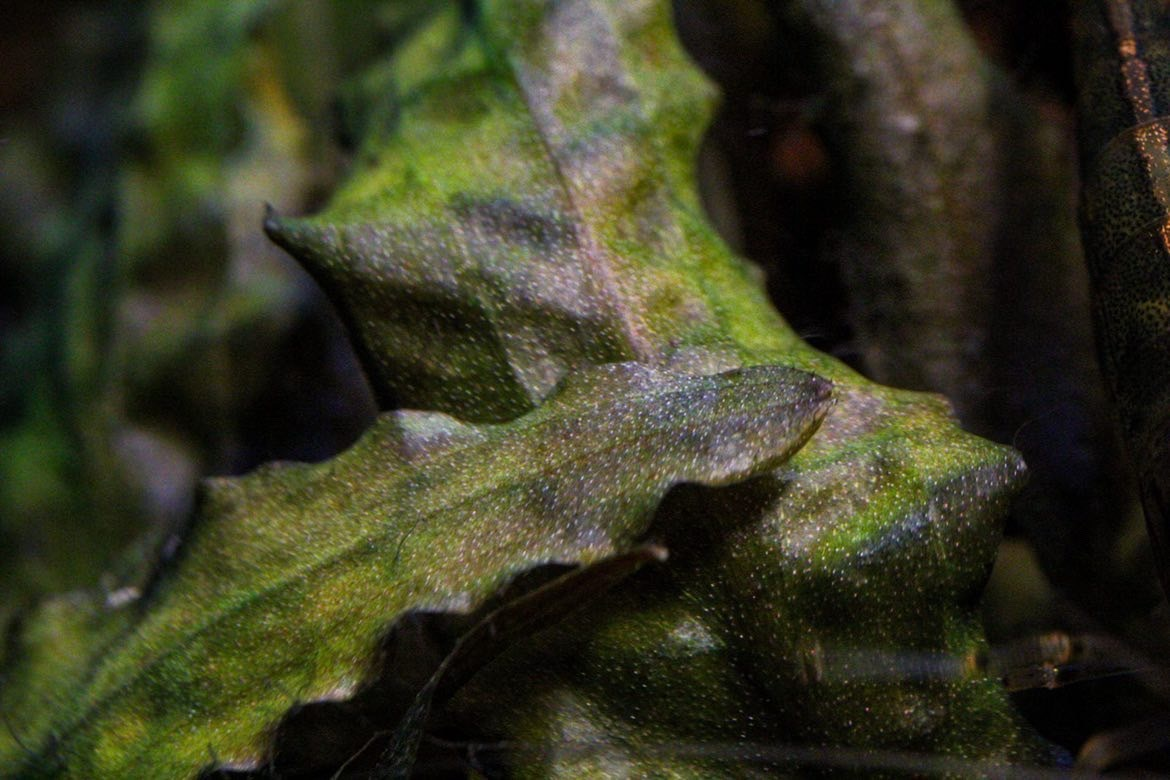
Low plants
Low aquatic plants are the lowest greenery point in the arrangement therefore best visible. These can be carpeting plants, ferns all small ornamental species that will impress the viewer from the front.
Java moss
This popular plant is often used in nature aquascaping and we know why! Its deep green colouration and quite low requirements are perfect for beginners who want to have a thick carpet. Using cotton thread, Java moss can be tied to driftwood or rocks. This is the safest way to attach them to the hardscape. This plant species will blend into the jungle style arrangement perfectly.
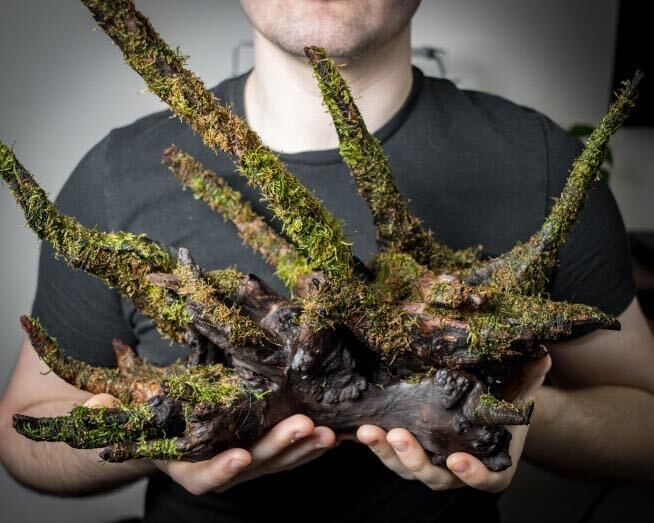
Generally, the success of any carpeting plant is the regular trimming as the overgrown carpet doesn’t look visually appealing and algae can easily settle down in the carpet (fertilized by compounds from the substrate and lighting).
Secondly, After every trimming, grab as much plant remains as possible and do a water change. The plant remains will start rotten which will affect the water parameters and purity.
Eleocharis parvula
Another carpeting plant that will perfect in iwagumi-inspired aquascapes. Perfect to reflect hills covered with grass. It roots better in fine substrate. It also doesn’t require strong lighting to thrive, however correlated with CO2 supplementation, it will spread faster and the colouration will be intensified. Regular pruning is also very important for this plant species.
Monte Carlo
This carpeting species requires minimum maintenance. Thanks to the strong root system (of course strong in terms of carpeting plants) it’s less fragile. It has similar appearance to HC Cuba but it’s definitely easier to grow under mid lighting. Again, don’t overgrow the carpet as the bottom parts may get yellowish because of the poor light access.

Water parameters
All of the above species can be grown together in moderate lighting and CO2 supplementation. The water temperature suitable for all the species (together) should not extend 27 degrees Celsius and the pH should oscillate between 5.9-7.2. In setups with fish, the carbon dioxide dosing should be specially observed in the drop checker and bubble counter.
Do you feel inspired?
In this article we tried to introduce you to the world of aquascaping- an amazing passion that is gaining popularity in recent years. Aquascaping involves a lot of skills including spacial imagination, the ability to predict the nature, understanding the environmental stability, manual skills and open mind. Try this adventure and check how relaxing this hobby is and how much happiness it can bring to our lives.


Comments ( 13 )